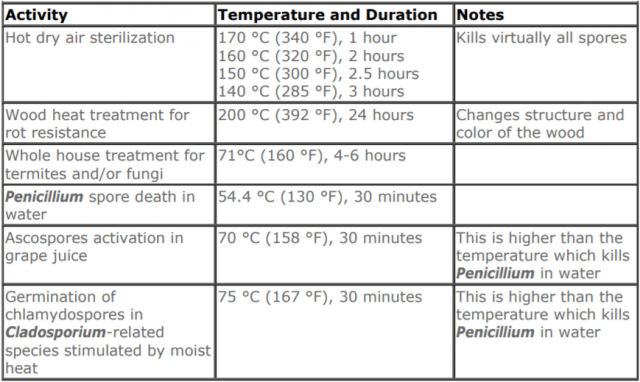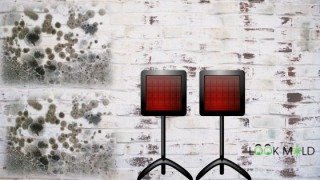Does Heat Kill Mold? Yes, But There is A Catch
Expert insight by: Brad Fishbein, Licensed Mold Assessor
Updated February 4, 2023
Many products on the market today claim to kill mold, but what if you don’t need any specific product?
What if you can use something very natural such as temperature.
Can heat kill mold?
In this article, we will go over everything you need to know about using heat to kill mold.
Does Heat Kill Mold?
Yes, temperatures of 140-160°F (60-71°C) can kill most mold spores in both foods and on building materials. Some mold species do produce heat-resistant spores that can survive extreme heat such as a mold named Byssochlamys fulva but can still be killed with heat when boiled in water at 212°F(100°C) for over a minute. Source: usda.gov
 (source)
(source)
While most mold will grow and thrive in warm to hot temperatures, multiple studies suggest that extreme heat over 140°F / 60°C will kill mold. Heat can also be used to remove surface mold off mold contaminated wood that was pressure cleaned.
So yes, heat will kill mold, but there is more to the story that you must know.
Heat Does Not Get Rid Of Mold

While yes, heat does kill mold; it does not get rid of it. Just because the mold has been “cooked,” dormant mold will still be present and not magically disappear alotgether.
There is one misconception when it comes to mold…
Dead mold can affect humans just as much as living mold.
In many cases, when water-damaged building materials are dried by heat with mold present on it, the mold spores will become more airborne than when they were wet.
The reason is that the mold spores will not be as heavy when they are dry. The dead mold spores can be dispersed into the air and travel through your air conditioning ductwork.
Mold, damaged building materials will need to be removed. Some remediation companies claim that if you have dead mold within your walls, it will not affect you.
However, standards in the industry always recommend removing the mold and not just leaving it dormant.
Problems With Using Air Blowers
Some of the products used to distribute hot air can cause more harm than good.
Because the machines are blowing air, it’s going to be blowing mold spores around. It’s the same reason if you have a flood in your house and there is already mold present, the emergency dry out company won’t install fans.
They don’t want to cross-contaminate your home.
Unless the mold affected area is already a containment zone with air scrubbers set up to capture the mold spores, units that blow hot air is not the best idea.
Using heat to kill mold can be an added tool for mold remediation professionals. Still, it should not be used by an everyday person that is not familiar with procedures to prevent cross-contamination.
High temperatures can also cause damage to other belongings in the house. Plastic can let off chemicals when burned. Precautions will need to be taken to protect furnishings in the home as well as to prevent a fire.
Using Heat To Kill Mold Vs. Using A Fungicide
Heat is recommended for the choice over a fungicide or disinfectant mainly because it does not have any chemicals. You don’t have to choose between the two, though. Both chemicals and heat can be used to kill mold, but neither should be the sole source of mold remediation.
Heat can have a positive effect on penetrating wall cavities compared to disinfectants.
But again…
If mold is suspected to be found inside a wall cavity, the wall covering should be removed.
Conclusion
Does heat kill mold?
Yes, it does. However, it does come with some drawbacks that need to be accounted for.
Heat is one of many processes that can be used in the mold abatement process.
Explore Related Topics:

Meet the author: Brad Fishbein is an ACAC council-certified Microbial Investigator. In the fall of 2012, he became a Licensed Mold Assessor in the State of Florida through the Department of Business & Professional Regulation. Brad has helped homeowners with over 5,000 successfully completed Mold Inspections since 2009.

